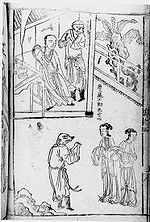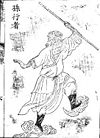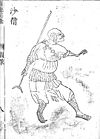- Journey to the West
-
For other uses, see Journey to the West (disambiguation).
Journey to the West
西遊記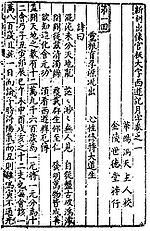
The earliest known edition of Journey to the West (block print), Chinese, 16th century.Author(s) Wu Cheng'en Original title 西遊記 Country China Language Chinese Media type Print ISBN 7119016636 Journey to the West Traditional Chinese 西遊記 Simplified Chinese 西游记 Hanyu Pinyin Xī Yóu Jì Transcriptions Mandarin - Hanyu Pinyin Xī Yóu Jì - Wade–Giles Hsi-yu chi - IPA ɕí i̯ǒʊ̯ tɕî Min - Hokkien POJ Se-iû-kì 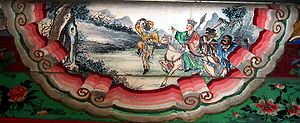 The four heroes of the story, left to right: Sūn Wùkōng (Monkey King), Xuánzàng (on the Dragon-Horse), Zhū Bājiè, and Shā Wùjìng.
The four heroes of the story, left to right: Sūn Wùkōng (Monkey King), Xuánzàng (on the Dragon-Horse), Zhū Bājiè, and Shā Wùjìng.
Journey to the West (西遊記) is one of the Four Great Classical Novels of Chinese literature. It was written by Wu Cheng'en in the 16th century. In English-speaking countries, the tale is also often known simply as Monkey. This was one title used for a popular, abridged translation by Arthur Waley. The Waley translation has also been published as Adventures of the Monkey God, Monkey: [A] Folk Novel of China, and The Adventures of Monkey, and in a further abridged version for children, Dear Monkey.
The novel is a fictionalised account of the legendary pilgrimage to India of the Buddhist monk Xuanzang, and loosely based its source from the historic text Great Tang Records on the Western Regions and traditional folk tales. The monk travelled to the "Western Regions" during the Tang Dynasty, to obtain sacred texts (sūtras). The Bodhisattva Guan Yin, on instruction from the Buddha, gives this task to the monk and his three protectors in the form of disciples — namely Sun Wukong, Zhu Bajie and Sha Wujing — together with a dragon prince who acts as Xuanzang's steed, a white horse. These four characters have agreed to help Xuanzang as an atonement for past sins.
Journey to the West has a strong background in Chinese folk religion, Chinese mythology and value systems; the pantheon of Taoist immortals and Buddhist bodhisattvas is still reflective of some Chinese religious beliefs today. Enduringly popular, the tale is at once an adventure story, a spring of spiritual insight, and an extended allegory in which the group of pilgrims journeying toward India represents individuals journeying toward enlightenment.
Contents
Authorship
Journey to the West is thought to have been written and published anonymously by Wu Cheng'en in the 16th century.[1] At the time, the trend in writing was to write in Classical Chinese along the literature of the Han and Tang periods. Wu, influenced heavily by popular stories and folk tales since his childhood, chose instead to write this novel in vernacular Chinese, the "vulgar" language used in the everyday lives of common people, publishing it anonymously because of the ill repute such works engendered.[1] The people of Wu's hometown, however, attributed it early on to Wu, and kept records to that effect as early as 1625; thus, Journey to the West was one of the earliest Chinese novels for which the authorship is officially documented.[1] The novel was first published in print in the 1590s.
Some scholars still have doubts about the novel's authorship.[2][3] Translator W.F.J. Jenner, for example, points out that although Wu had knowledge of Chinese bureaucracy and politics, the novel itself does not include any political details that "a fairly well-read commoner could not have known."[2] The question of authorship is further complicated by the preexistence of much of the novel's material in the form of folk tales.[2] In any case, Journey to the West has become the authoritative version of these stories,[2] and Wu's name has become inextricably linked with the book.[3]
Synopsis
The novel is comprised of 100 chapters. These can be divided into four very unequal parts. The first, which includes chapters 1–7, is really a self-contained introduction to the main story. It deals entirely with the earlier exploits of Sun Wukong, a monkey born from a stone nourished by the Five Elements, who learns the art of the Tao, 72 polymorphic transformations, combat, and secrets of immortality, and through guile and force makes a name for himself as the Qitian Dasheng (simplified Chinese: 齐天大圣; traditional Chinese: 齊天大聖), or "Great Sage Equal to Heaven". His powers grow to match the forces of all of the Eastern (Taoist) deities, and the prologue culminates in Sūn's rebellion against Heaven, during a time when he garnered a post in the celestial bureaucracy. Hubris proves his downfall when the Buddha manages to trap him under a mountain, sealing the mountain with a talisman for five hundred years.
Only following this introductory story is the nominal main character, Xuanzang, introduced. Chapters 8–12 provide his early biography and the background to his great journey. Dismayed that "the land of the South knows only greed, hedonism, promiscuity, and sins", the Buddha instructs the Bodhisattva Guan Yin to search Tang China for someone to take the Buddhist sutras of "transcendence and persuasion for good will" back to the East. Part of the story here also relates to how Xuánzàng becomes a monk (as well as revealing his past life as a disciple of the Buddha named "Golden Cicada" (金蟬子) and comes about being sent on this pilgrimage by Emperor Taizong of Tang, who previously escaped death with the help of an underworld official).
The third and longest section of the work is chapters 13–99, an episodic adventure story in which Xuanzang sets out to bring back Buddhist scriptures from Vulture Peak in India, but encounters various evils along the way. The section is set in the sparsely-populated lands along the Silk Road between China and India, including Xinjiang, Turkestan, and Afghanistan. The geography described in the book is, however, almost entirely fantastic; once Xuánzàng departs Chang'an, the Tang capital, and crosses the frontier (somewhere in Gansu province), he finds himself in a wilderness of deep gorges and tall mountains, inhabited by demons and animal spirts, who regard him as a potential meal (since his flesh was believed to give immortality to whoever ate it), with the occasional hidden monastery or royal city-state amidst the harsh setting.
Episodes consist of 1–4 chapters and usually involve Xuánzàng being captured and having his life threatened while his disciples try to find an ingenious (and often violent) way of liberating him. Although some of Xuanzang's predicaments are political and involve ordinary human beings, they more frequently consist of run-ins with various demons, many of whom turn out to be earthly manifestations of heavenly beings (whose sins will be negated by eating the flesh of Xuanzang) or animal-spirits with enough Taoist spiritual merit to assume semi-human forms.
Chapters 13–22 do not follow this structure precisely, as they introduce Xuanzang's disciples, who, inspired or goaded by Guan Yin, meet and agree to serve him along the way in order to atone for their sins in their past lives.
- The first is Sun Wukong (simplified Chinese: 孙悟空; traditional Chinese: 孫悟空), or Monkey, previously "Great Sage Equal to Heaven", trapped by Buddha for rebelling against Heaven. He appears right away in Chapter 13. The most intelligent and violent of the disciples, he is constantly reproved for his violence by Xuanzang. Ultimately, he can only be controlled by a magic gold band that the Bodhisattva has placed around his head, which causes him unbearable headaches when Xuanzang chants the Tightening-Crown spell.
- The second, appearing in chapter 19, is Zhu Bajie (simplified Chinese: 猪八戒; traditional Chinese: 豬八戒), literally Eight-precepts Pig, sometimes translated as Pigsy or just Pig. He was previously Marshal Tianpeng (simplified Chinese: 天蓬元帅; traditional Chinese: 天蓬元帥), commander of the Heavenly Naval forces, banished to the mortal realm for flirting with the Princess of the Moon Chang'e. A reliable fighter, he is characterized by his insatiable appetites for food and sex, and is constantly looking for a way out of his duties, which causes significant conflict with Sun Wukong.
- The third, appearing in chapter 22, is the river-ogre Sha Wujing (simplified Chinese: 沙悟净; traditional Chinese: 沙悟淨), also translated as Friar Sand or Sandy. He was previously the celestial Curtain-lifting General (simplified Chinese: 卷帘大将; traditional Chinese: 捲簾大將), banished to the mortal realm for dropping (and shattering) a crystal goblet of the Heavenly Queen Mother. He is a quiet but generally dependable character, who serves as the straight foil to the comic relief of Sun and Zhu.
- The fourth disciple is the third prince of the Dragon-King, Yulong Santaizi (simplified Chinese: 玉龙三太子; traditional Chinese: 玉龍三太子), who was sentenced to death for setting fire to his father's great pearl. He was saved by Guan Yin from execution to stay and wait for his call of duty. He appears first in chapter 15, but has almost no speaking role, as throughout most of the story he appears in the transformed shape of a horse that Xuanzang rides on.
Chapter 22, where Sha Wujing is introduced, also provides a geographical boundary, as the river that the travelers cross brings them into a new "continent". Chapters 23–86 take place in the wilderness, and consist of 24 episodes of varying length, each characterized by a different magical monster or evil magician. There are impassably wide rivers, flaming mountains, a kingdom ruled by women, a lair of seductive spider-spirits, and many other fantastic scenarios. Throughout the journey, the four brave disciples have to fend off attacks on their master and teacher Xuanzang from various monsters and calamities.
It is strongly suggested that most of these calamities are engineered by fate and/or the Buddha, as, while the monsters who attack are vast in power and many in number, no real harm ever comes to the four travelers. Some of the monsters turn out to be escaped heavenly animals belonging to bodisattvas or Taoist sages and spirits. Towards the end of the book there is a scene where the Buddha literally commands the fulfillment of the last disaster, because Xuanzang is one short of the eighty-one disasters he needs to attain Buddhahood.
In chapter 87, Xuanzang finally reaches the borderlands of India, and chapters 87–99 present magical adventures in a somewhat more mundane (though still exotic) setting. At length, after a pilgrimage said to have taken fourteen years (the text actually only provides evidence for nine of those years, but presumably there was room to add additional episodes) they arrive at the half-real, half-legendary destination of Vulture Peak, where, in a scene simultaneously mystical and comic, Xuanzang receives the scriptures from the living Buddha.
Chapter 100, the last of all, quickly describes the return journey to the Tang Empire, and the aftermath in which each traveler receives a reward in the form of posts in the bureaucracy of the heavens. Sun Wukong and Xuanzang achieve Buddhahood, Sha Wujing becomes an arhat, the dragon horse is made a nāga, and Zhu Bajie, whose good deeds have always been tempered by his greed, is promoted to an altar cleanser (i.e. eater of excess offerings at altars).
Historical context
Main article: XuanzangThe classic story of the Journey to the West was based on real events. In real life, Xuanzang (born c. 602 - 664) was a monk at Jingtu Temple in late-Sui Dynasty and early-Tang Dynasty Chang'an. Motivated by the poor quality of Chinese translations of Buddhist scripture at the time, Xuanzang left Chang'an in 629, despite the border being closed at the time due to war with the Gokturks. Helped by sympathetic Buddhists, he travelled via Gansu and Qinghai to Kumul (Hami), thence following the Tian Shan mountains to Turpan. He then crossed what are today Kyrgyzstan, Uzbekistan, and Afghanistan, into Gandhara, reaching India in 630. Xuanzang travelled throughout the Indian subcontinent for the next thirteen years, visiting important Buddhist pilgrimage sites and studying at the ancient university at Nalanda.
Xuanzang left India in 643 and arrived back in Chang'an in 646 to a warm reception by Emperor Taizong of Tang. He joined Da Ci'en Monastery (Monastery of Great Maternal Grace), where he led the building of the Big Wild Goose Pagoda in order to store the scriptures and icons he had brought back from India. He recorded his journey in the book Great Tang Records on the Western Regions. With the support of the Emperor, he established an institute at Yuhua Gong (Palace of the Lustre of Jade) monastery dedicated to translating into Chinese the scriptures he had brought back. His translation and commentary work established him as the founder of the Dharma character school of Buddhism. Xuanzang died on March 7, 664. The Xingjiao Monastery was established in 669 to house his ashes.
Popular stories of Xuanzang's journey were in existence long before Journey to the West was written. In these versions, dating as far back as Southern Song, a monkey character was already a primary protagonist. Before the Yuan Dynasty and early Ming, elements of the Monkey story were already seen.
Main characters
Further information: List of Journey to the West charactersTripitaka or Xuanzang
Main article: Xuanzang (fictional character)The monk Xuánzàng (陈玄奘) (or Táng-Sānzàng (唐三藏), "Tang-dynasty monk" — Sānzàng (三藏) or "Three Hiddens", refers to the Tripitaka, a traditional honorific for a Buddhist monk) is the Buddhist monk who had renounced his family to become a monk from childhood. He set off for Dahila kingdom 天竺国(an appellation for India in Ancient China) to retrieve the Buddhist scriptures for China. He is just called Tripitaka in many English versions of the story. Although he is helpless in defending himself, the bodhisattva Guānyīn helps by finding him powerful disciples who aid and protect him on his journey. In return, the disciples will receive enlightenment and forgiveness for their sins once the journey is done. Along the way, they help the local inhabitants by defeating various monsters and demons who try to obtain immortality by eating Xuánzàng's flesh.
Monkey King or Sun Wukong
Main article: Sun WukongSūn Wùkōng is the name given to this character by his teacher, Patriarch Subhuti, which means "Awakened to Emptiness" (in the Waley translation, Aware-of-Vacuity); he is called Monkey King. He is born on Flower Fruit Mountain from a stone egg that forms from an ancient rock created by the coupling of heaven and earth. He first distinguishes himself by bravely entering the Cave of Water Curtains on the mountain; for this feat, his monkey tribe gives him the title of "Handsome Monkey-King". After angering several gods and coming to the attention of the Jade Emperor, he is given a minor position in heaven as the Protector of Horses (弼马温) so they can keep an eye on him. This job is a very low position, and when he realizes that he is put into such a low position and not considered a full-fledged god, he becomes very angry. Upon returning to his mountain, he puts up a flag and declares himself the "Great Sage Equaling Heaven." Then the Jade emperor dispatches celestial soldiers to arrest Sun Wukong, but no one succeeds. The Jade emperor has no choice but to appoint him to be the patrolman of the heavenly peach garden. The peaches in the garden bear fruit every 3,000-years, eating its flesh will bestow immortality, so Wukong eats one and becomes more powerful and matchless. Later, after fairies who come to collect peaches for the heavenly peach banquet inform Wukong he is not invited and make fun of him, he starts making trouble in Heaven and defeats an army of 100,000 celestial soldiers, led by the Four Heavenly Kings, Erlang Shen, and Nezha. Eventually, the Jade Emperor appeals to Buddha, who detains Wukong under a mountain called Five Elements Mountain (五行山). Wukong is kept under the mountain for 500 years, and cannot escape because of a spell that was put on the mountain. He is later set free when Xuanzang comes upon him during his pilgrimage and accepts him as a disciple.
His primary weapon is the "will-following golden-banded staff," which he can shrink down to the size of a needle and keep behind his ear, as well as expand it to gigantic proportions (hence the "will-following" part of the name). The staff, originally a pillar supporting the undersea palace of the Dragon King of the East Sea, weighs 18,000 pounds, which he pulls out of its support and swings with ease. The Dragon King of the East Sea had told Wukong he could have the staff if he could lift it, but was angry when Wukong was actually able to pull it out and accused him of being a thief; hence Wukong was insulted, so he demanded a suit of armor and refused to leave until he received one. The Dragon King, unwilling to see a monkey making troubles in his favorite place, also gave him a suit of golden armor. These gifts, combined with his devouring of the peaches of immortality, three jars of immortality pills, and his time being tempered in Laozi's eight-trigram furnace(he was put in there to be executed, but instead the furnace gave him a steel-hard body and fiery golden eyes that can see very far and see through any disguise, but his eyes are weak to smoke. he is always able to recognize a demon in disguise, even though the rest of the pilgrimage can not), makes Sun the strongest member of the pilgrimage by far. Besides these abilities, he can also pluck hairs from his body and blow on them to convert them into whatever he wishes (usually clones of himself to gain a numerical advantage in battle). Although he is a master of the 72 methods of transformation (七十二变),[4] such as birds, which would give him the ability to fly, he can also do a "cloud somersault," enabling him to travel vast distances in a single leap. The monkey, nimble and quick-witted, uses these skills to defeat all but the most powerful of demons on the journey.
Sun's behavior is checked by a band placed around his head by Guan Yin Bodhisattva, which cannot be removed by Sun himself until the journey's end. Xuanzang can tighten this band by chanting the "Tightening-Crown spell" (taught to him by Guan Yin) whenever he needs to chastise him. The spell is referred to by Xuanzang's disciples as the "Headache Sutra", which is the Buddhist mantra "oṃ maṇipadme hūṃ." Xuanzang speaks this mantra quickly in repetition.
Sun's child-like playfulness is a huge contrast to his cunning mind. This, coupled with his great power, makes him a Trickster hero. His antics present a lighter side in what proposes to be a long and dangerous trip into the unknown.
Zhu Bajie
Main article: Zhu BajieZhū Bājiè ("Pig of the Eight Prohibitions") is also known as Zhū Wùnéng ("Pig Awakened to Ability"), and given the name Pigsy, Monk Pig or just simply Pig in English.
Once an immortal who was the Marshal Tianpeng of 100,000 soldiers of the Milky Way, he drank too much during a celebration of gods and attempted to flirt with Cháng'é, the beautiful moon goddess, resulting in his banishment into the mortal world. He was supposed to be reborn as a human, but ends up in the womb of a female boar due to an error at the Reincarnation Wheel, which turns him into a half-man half-pig monster. Zhu Bajie was very greedy, and could not survive without eating ravenously. Staying within Yúnzhan-dòng ("cloud-pathway cave"), he was commissioned by Guan Yin to accompany Xuanzang to India and given the new name Zhu Wuneng.
However, Zhu's indulgence in women's beauty led him to Gaojiazhuang Village, where he posed as a normal being and wedded a maiden. Later, when the villagers discovered that he was a monster, Zhu hid the girl away, and the girl wailed bitterly every night. At this point, Xuanzang and Sun Wukong arrived at Gaojiazhuang Village and helped defeat him. Renamed Zhu Bajie by Xuanzang, he consequently joined the pilgrimage to the West.
His weapon of choice is the jiǔchǐdīngpá ("nine-tooth iron rake"). He is also capable of thirty-six transformations (as compared to Sun Wukong's seventy-two), and can travel on clouds, but not as fast as Sun. However, Zhu is noted for his fighting skills in water, which he used to combat Sha Wujing, who later joined them on the journey. He is the second strongest member of the team.
Sha Wujing
Main article: Sha WujingShā Wùjìng 沙悟净 (literally meaning "Sand Awakened to Purity"), given the name Friar Sand or Sandy in English, was once the Curtain Raising General, who stood in attendance by the imperial chariot in the Hall of Miraculous Mist. He was exiled to the mortal world and made to look like a monster because he accidentally smashed a crystal goblet belonging to the Heavenly Queen Mother during the Peach Banquet. The now-hideous immortal took up residence in the Flowing Sands River, terrorizing the surrounding villages and travelers trying to cross the river. However, he was subdued by Sun Wukong and Zhu Bajie when Xuanzang's party came across him. They consequently took him in, as part of the pilgrimage to the West.
Sha's weapon is the yuèyáchǎn ("Crescent-Moon-Shovel" or "Monk's Spade"). He also knows eighteen transformation methods and is highly effective in water combat. He is about as strong as Zhu Bajie, and is much stronger than Wùkōng in water. However, Zhu can defeat Sha in a test of endurance, and Sun can defeat him on land.
Sha is known to be the most obedient, logical, and polite of the three disciples, and always takes care of his master, seldom engaging in the bickering of his fellow disciples. He has no major faults nor any extraordinary characteristics. Perhaps this is why he is sometimes seen as a minor character.
Sha eventually becomes an Arhat at the end of the journey, giving him a higher level of exaltation than Zhu, who is relegated to cleaning every altar at every Buddhist temple for eternity, but is still lower spiritually than Sun or Xuanzang, who are granted Buddhahood.
Sequels
The brief satirical novel Xiyoubu (西游补, "Supplement to the Journey to the West," c. 1640) follows Sun as he is trapped in a magical dream world created by the Qing Fish Demon, the embodiment of desire (情, qing). Sun travels back and forth through time, during which he serves as the adjunct King of Hell and judges the soul of the recently dead traitor Qin Hui during the Song Dynasty, takes on the appearance of a beautiful concubine and causes the downfall of the Qin Dynasty, and even faces King Paramita, one of his five sons born to the demoness Princess Iron Fan,[5] on the battlefield during the Tang Dynasty.[6] The events of the Xiyoubu take place between the end of chapter 61 and the beginning of chapter 62 of Journey to the West.[7] The author, Tong Yue (童说), wrote the book because he wanted to create an opponent—in this case desire—that Sun could not defeat with his great strength and martial skill.[8]
Notable English-language translations
- Monkey: A Folk-Tale of China (1942), an abridged translation by Arthur Waley. For many years, the most well-known translation available in English. Waley noted in his preface that the novel was usually read in abridgement in Chinese. "The method adopted in these abridgements is to leave the original number of separate episodes, but drastically reduce them in length, particularly by cutting out dialogue. I have for the most part adopted the opposite principle, omitting many episodes, but translating those that are retained almost in full, leaving out, however, most of the incidental passages in verse, which go very badly into English.".[9] The degree of abridgement, 30 out of the 100 chapters (which corresponds to roughly 1/6 of the whole text), and the excising, e.g., most of the verse, has led to some recent critics awarding it the lesser place of a good retelling of the story.[10] On the other hand, it has been praised as "remarkably faithful to the original spirit of the work." [11]
- Journey to the West (1982–1984), a complete translation in three volumes by W.J.F. Jenner. Readable translation without scholarly apparatus.[12] Foreign Languages Press Beijing (ISBN 0-8351-1003-6, ISBN 0-8351-1193-8, ISBN 0-8351-1364-7; 1993 edition in four volumes: ISBN 978-7-119-01663-4; 2003 edition in six volumes with original Chinese on left page, English translation on right page: ISBN 7-119-03216-X)
- The Journey to the West (1977–1983), a complete translation in four volumes by Anthony C. Yu. Complete translation with extensive scholarly introduction and notes.[12] University of Chicago Press: HC ISBN 0-226-97145-7, ISBN 0-226-97146-5, ISBN 0-226-97147-3, ISBN 0-226-97148-1; PB ISBN 0-226-97150-3, ISBN 0-226-97151-1; ISBN 0-226-97153-8; ISBN 0-226-97154-6. In 2006, an abridged version of this translation was published by Chicago UP under the title The Monkey and the Monk.
See also
- List of media adaptations of Journey to the West
References
- ^ a b c Hu Shih (1942). Introduction. New York: Grove Press. pp. 1–5.
- ^ a b c d Jenner, W.J.F. (1984). "Translator's Afterword." in trans. W.J.F. Jenner, Journey to the West, volume 4. Seventh Edition.
- ^ a b Shi Changyu (1999). "Introduction." in trans. W.J.F. Jenner, Journey to the West, volume 1. Seventh Edition. Beijing: Foreign Languages Press. pp. 1–22.
- ^ Here, 72 is not an assigned limit to Sun Wukong's power, but a number often used to denote infinity.
- ^ King Paramita is the only son to make an appearance and to be called by name in the novel. These sons did not originally appear in Journey to the West.
- ^ Tong, Yue, Shuen-fu Lin, Larry James Schulz, and Chengẻn Wu. The Tower of Myriad Mirrors: A Supplement to Journey to the West. Michigan classics in Chinese studies, 1. Ann Arbor: Center for Chinese Studies, The University of Michigan, 2000
- ^ Tong, The Tower of Myriad Mirrors, p. 5
- ^ Tong, The Tower of Myriad Mirrors, p. 133
- ^ Wu Ch'eng-en, Monkey, trans. Arthur Waley, [1943] (New York: Grove Press, 1984), preface p. 7
- ^ Plaks, Andrew (1997). "The Journey to the West by Anthony C. Yu." MLN, Vol. 92, No. 5, Comparative Literature. 1116–1118."
- ^ Paul S. Ropp, "The Distinctive Art of Chinese Fiction", in Paul S. Ropp ed., Heritage of China: Contemporary Perspectives on Chinese Civilization (Berkeley: University of California Press, 1990), p. 321n.12
- ^ a b Plaks, Andrew (1994). "Journey to the West". In Miller, Barbara S. (ed.): Masterworks of Asian Literature in Comparative Perspective. New York: M.E. Sharpe. p. 283.
Further reading
- Jenner, W.J.F. (1984). "Translator's Afterword." in trans. W.J.F. Jenner, Journey to the West, volume 4. Seventh Edition. Beijing: Foreign Languages Press. 2341–2343.
- Shi Changyu 石昌渝 (1999). "Introduction." in trans. W.J.F. Jenner, Journey to the West, volume 1. Seventh Edition. Beijing: Foreign Languages Press. 1–22.
- Yu, Anthony. "Introduction". Journey to the West. Trans. and ed. Anthony Yu. Vol. 1. Chicago - London: University of Chicago Press, 1977. 1–62.
Critical studies
- Fu, James S. Mythic and Comic Aspects of the Quest. Singapore: Singapore University Press, 1977.
- Hsia, C.T. "The Journey to the West". The Classic Chinese Novel. New York: Columbia UP, 1968. 115–164.
- Kao, Karl S.Y. "An Archetypal Approach to Hsi-yu chi." Tamkang Review 5, no.2 (Oct 1974). 63–98.
- Plaks, Andrew. The Four Masterworks of the Ming Novel. Princeton: Princeton UP, 1987. 183–276.
- ---. "Journey to the West". Miller, Barbara S. (ed.): Masterworks of Asian Literature in Comparative Perspective. New York - London: M.E. Sharpe, 1994. 272–284.
- Yu, Anthony C. "Two Literary Examples of Religious Pilgrimage: The Commedia and the Journey to the West." History of Religions 22, no. 3 (Feb 1983). 202–230.
External links
Full text
Traditional Chinese
- Journey to the West from the Gutenberg Project (UTF-8 encoding)
- Journey to the West from Open Lit (Big5 encoding)
Simplified Chinese
- Journey to the West from Xahlee (UTF-16 encoding)
English
- Journey to the West - Freeware complete English text version in PDF format (2.56MB)
Other links
Four Great Chinese Classical Novels Chinese mythology Overview topics Major entities Creatures Bixie · Black Tortoise · Azure Dragon · White Tiger · Vermilion Bird · Qilin · Fenghuang · Huli jing · Chinese guardian lions · Píxiū · NiánPlaces Popular literary works Shan Hai Jing · Shi Yi Ji · The Peach Blossom Spring · Fengshen Bang · Legend of the White Snake · Strange Stories from a Chinese Studio · Journey to the West · In Search of the Supernatural · Zi Bu Yu · Tian Xian PeiCategories:- Chinese classic novels
- Journey to the West
- 16th-century novels
- Literature featuring anthropomorphic characters
- Ming Dynasty literature
- Pilgrimage accounts
- Picaresque novels
- Books about India
- Works published anonymously
Wikimedia Foundation. 2010.

